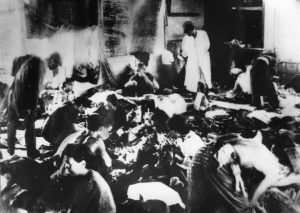Documenting Hiroshima of 1945: Mid-August, relief station was “hell on earth”
Aug. 18, 2024
by Minami Yamashita, Staff Writer
Even after mid-August in 1945, many wounded people were still being accommodated in the school building of the First National School (present-day Danbara Junior High School, in Hiroshima’s Naka Ward), which had been used as a temporary relief station starting soon after the bombing. The building, with straw mats covering its broken windows, was located 2.6 kilometers southeast of the hypocenter.
“A child’s voice saying ‘Miss, help me—it hurts,’ still rings in my ears,” said Yoshie Edo, 94, a resident of Higashihiroshima City in Hiroshima Prefecture, who cared for the wounded at the school building for around two weeks starting August 17. Ms. Edo was then a fourth-year student at Kamo Girls’ High School (present-day Kamo High School, in Higashihiroshima City) in the town of Saijo-cho in Hiroshima Prefecture. According to the school’s alumni association, third- and fourth-year students were sent to Hiroshima in different shifts as members of a relief team, based on a request from the Hiroshima Prefectural government.
Every morning during her stay, Ms. Edo would cook rice and prepare rice porridge in the school yard, using water leaking from a burst water pipe. She used bamboo to serve as rice bowls. When an infant held out its hands and said, “I want to eat,” Ms. Edo noticed maggots crawling from the child’s wounds. Because the patient could not chew food due to burns, she poured the porridge into the patient’s slightly opened mouth. The kasuri fabric the child had been wearing was burned out in the spots that were black, a color that readily absorbed heat, with only the white areas of the fabric remaining.
After being removed from the school building, corpses were cremated on a nearly daily basis in a large hole that had been dug up in the schoolyard. “The odor that arose every time the wind blew was unbearable.” Ms. Edo also remembers there being five or six children in the relief station who had no relatives or family to rely on.
“I witnessed hell on earth,” Ms. Edo said. The horrific circumstances of the relief station were photographed by Masami Onuka, a member of the photography team at the Imperial Japanese Army Shipping Command who died in 2011 at the age of 89, in the period between around August 7 and August 20, 1945.
(Originally published on August 18, 2024)
Even after mid-August in 1945, many wounded people were still being accommodated in the school building of the First National School (present-day Danbara Junior High School, in Hiroshima’s Naka Ward), which had been used as a temporary relief station starting soon after the bombing. The building, with straw mats covering its broken windows, was located 2.6 kilometers southeast of the hypocenter.
“A child’s voice saying ‘Miss, help me—it hurts,’ still rings in my ears,” said Yoshie Edo, 94, a resident of Higashihiroshima City in Hiroshima Prefecture, who cared for the wounded at the school building for around two weeks starting August 17. Ms. Edo was then a fourth-year student at Kamo Girls’ High School (present-day Kamo High School, in Higashihiroshima City) in the town of Saijo-cho in Hiroshima Prefecture. According to the school’s alumni association, third- and fourth-year students were sent to Hiroshima in different shifts as members of a relief team, based on a request from the Hiroshima Prefectural government.
Every morning during her stay, Ms. Edo would cook rice and prepare rice porridge in the school yard, using water leaking from a burst water pipe. She used bamboo to serve as rice bowls. When an infant held out its hands and said, “I want to eat,” Ms. Edo noticed maggots crawling from the child’s wounds. Because the patient could not chew food due to burns, she poured the porridge into the patient’s slightly opened mouth. The kasuri fabric the child had been wearing was burned out in the spots that were black, a color that readily absorbed heat, with only the white areas of the fabric remaining.
After being removed from the school building, corpses were cremated on a nearly daily basis in a large hole that had been dug up in the schoolyard. “The odor that arose every time the wind blew was unbearable.” Ms. Edo also remembers there being five or six children in the relief station who had no relatives or family to rely on.
“I witnessed hell on earth,” Ms. Edo said. The horrific circumstances of the relief station were photographed by Masami Onuka, a member of the photography team at the Imperial Japanese Army Shipping Command who died in 2011 at the age of 89, in the period between around August 7 and August 20, 1945.
(Originally published on August 18, 2024)








